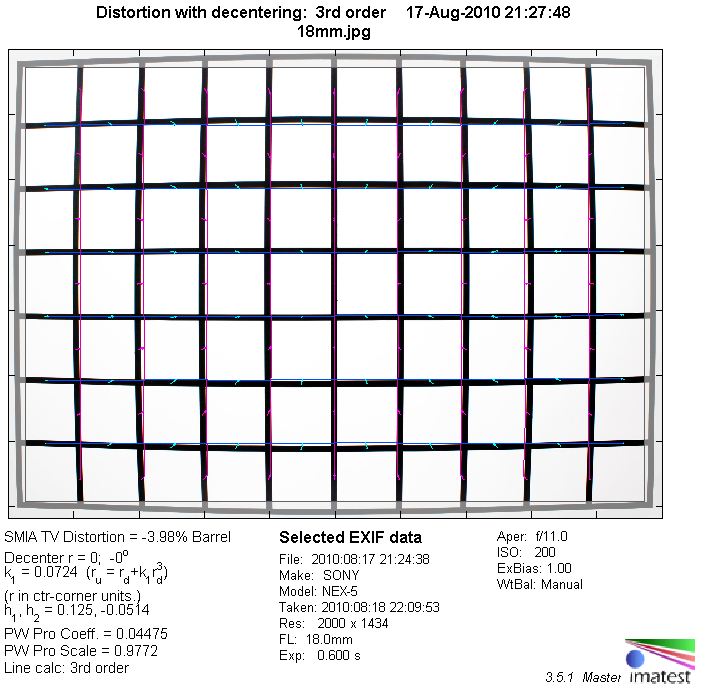|
Sony E 18-55mm f/3.5-5.6 OSS (Sony NEX) - Review / Re-Test - Analysis |
|
Lens Reviews -
Sony NEX
|
|
Page 2 of 2

Distortion
The 18-55mm OSS exhibits a fairly hefty amount of barrel distortion at 18mm (~4%). There is basically no distortion at 24mm but the characteristic turns to moderate (~2.1%) pincushion distortion at 35mm and slight (~1%) pincushion distortion at 55mm.
|
Move the mouse cursor over the focal length text marks below to observe the respective distortion
|
| 18mm |
24mm |
35mm |
55mm |

|
We have re-used the distortion figures from our initial test here. This aspect cannot change just by moving to a base camera with more megapixels.
Vignetting
In our first review we were rather baffled by the strange vignetting characteristic on the NEX 5. On the NEX 7 things are "back to normal" again so possibly we ran into some kind of auto-correction back then.
Anyway, the (real) light falloff at large apertures is rather heavy - especially at 18mm but also also beyond till about 35mm. This is rather typical for "kit" zoom lenses though as such maybe forgivable. Stopping down to f/5.6 helps already but you should choose f/8 in very critical situations in the low to mid zoom range. Vignetting is not an issue at 55mm.

MTF (resolution)
As already feared, the kit lens struggles with the difficult characteristic of the NEX 7 sensor. At 18mm the center quality is very fine indeed but the critical border and, especially, the corner quality is missing here - even when stopping down. The situation improves at 24mm to 55mm. The outer image regions remain quite soft at max. aperture but at f/8 the quality is actually quite good across the frame here. Still, this is all not impressive.
The centering quality of the tested lens wasn't great.
Please note that the MTF results are not directly comparable across the different systems!
Below is a simplified summary of the formal findings. The chart shows line widths per picture height (LW/PH) which can be taken as a measure for sharpness.
If you want to know more about the MTF50 figures you may check out the corresponding Imatest Explanations
Chromatic Aberrations (CAs)
Lateral CAs (color shadows at harsh contrast transitions) are another weak spot of the Sony lens. The issue is very pronounced at 18mm and 35mm at medium aperture settings and easily visible in images. Interestingly lateral CAs are not much of an issue at 24mm and especially 55mm.
 The CAs are measured at the "border" height. However, the issue continues to increases towards the extreme corners of the frame.
Just to give you an idea - here's a 100% crop of the corners at 35mm:
The CAs are measured at the "border" height. However, the issue continues to increases towards the extreme corners of the frame.
Just to give you an idea - here's a 100% crop of the corners at 35mm:

VerdictThe Sony E 18-55mm f/3.5-5.6 OSS may perform decently on lower resolution NEX cameras (the 3 and 5 series). However, its capabilities are clearly overstrained on Sony's 24 megapixel sensor. In so far it is very surprising that Sony is also offering it bundled with the NEX 7. The quality is rather miserable at 18mm and if you want to achieve reasonably sharp results across the image field you should generally avoid large aperture settings at the other focal lengths as well. Another weakness is the high amount of lateral CAs at 18mm and 35mm. This decreases the subjective quality perception quite a bit if you don't take care of it during post-processing or by activating the CA auto-compensation in the camera. The distortion characteristic is about average for a lens in this class - heavy barrel distortion at 18mm and slight to moderate pincushion distortion towards the long end of the range. If you disable the vignetting compensation you will have to live with a rather heavy light falloff between 18-35mm at large apertures.
Sony's OSS seems to be as efficient as the more established systems by Nikon and Canon. The AF is virtually silent and as such also very usable for shooting movies. A really nice aspect, and that's typical for all Sony E lenses so far, is the build quality. A kit lens with a body made of mag-alloy is pretty much unique and it's certainly a differentiator when comparing different systems in shops out there - a smart move by Sony for sure here. However, it is obvious that this fairly new lens is already outdated - it is just not good enough anymore at 24 megapixels.
|